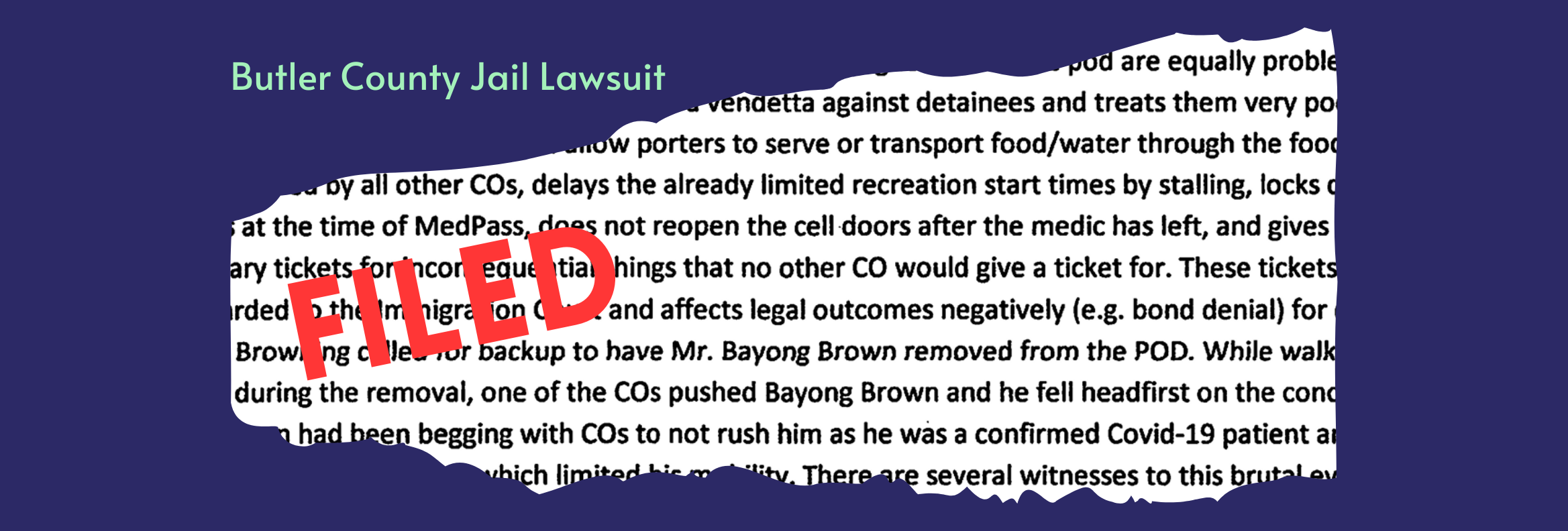UPDATE: Sheriff Jones posted a photo on Facebook saying that his jail is back in business with ICE. Below find a statement from Lynn Tramonte, background on ICE detention, and a Butler County-ICE timeline.
Statement from Lynn Tramonte, Executive Director of the Ohio Immigrant Alliance
“Sheriff Jones is using examples of immigrants who commit crimes to justify restarting his Immigration and Customs Enforcement (ICE). But he already has the authority to detain anyone who commits a criminal offense that permits their incarceration. Even Jones admits people born in other countries commit fewer crimes than those of us who were born here. That’s not what this is about. It’s about giving Sheriff Jones the authority to arrest people who have NOT been accused or convicted of committing crimes. It’s called ‘civil detention’ but it takes place in a jail. It’s already dystopian and inhumane to put people who are following an immigration process in jail while their cases are pending, sometimes indefinitely. But that is what ICE jail is.
“Let’s be clear. Jones is seeking additional authority to detain people who are NOT subject to criminal arrest and prosecution. That means he wants to put moms and dads who have pending immigration cases into jail. People who have applied for asylum in the United States, including people with legal work permits. People whose lives would be in danger if they are deported. If that sounds wrong, that’s because it is. Jones needs a federal contract to obtain this extra authority. If he was focused on people who commit crimes, he would not need an ICE contract.
“The other thing we know is that the Butler County Jail has a history of abuses. People have died in this jail because they were denied medical treatment, including people suffering from withdrawal. Sheriff Jones refused to give U.S. citizens the care they needed; their deaths were preventable. The Jail’s actions in these and other cases shock the conscious. There is also a civil rights lawsuit pending against the Butler County Jail due to its abuses of immigrants detained there for ICE during the first Trump administration. If Jones is able to restart his ICE contract, he and Butler County will be under a microscope. Immigrants have rights. When counties sign an ICE contract, they agree to treat people with dignity. That means access to medical care, the ability to speak with their lawyers, religious freedom, a certain standard of food, and more.
“A group of organizations led by the ACLU of Ohio, Ohio Immigrant Alliance, sent a letter to all of Ohio’s sheriffs, warning them that becoming arms of the immigration police will cost them and their communities in public trust, community safety, and tax dollars. It’s clear that Jones doesn’t see immigrants’ basic humanity, but he doesn’t speak for everyone in Ohio. Many Ohioans see immigrants as valued members of our families and communities, and know that Ohio is home.
“No person is above the law — including the sheriff.”
Police Involvement in Civil Immigration Enforcement Is Costly — In Tax Dollars, and Public Trust
ICE detention is purportedly “civil” confinement, but takes place in punitive settings like county and private jails. The federal government may detain immigrants awaiting a decision on their civil immigration cases in facilities with which it establishes contracts. Jailers are legally obligated to provide immigrants with medical care, decent food, legal access, and freedom of religion, as well as to not cause them harm. Since immigrants are not serving court-ordered, temporal sentences, but waiting for a bureaucratic process to conclude, the loss of freedom is indefinite.
There is a growing movement calling for an end to ICE detention. In the meantime, facilities are required to ensure the basic human and civil rights of people it incarcerates for ICE.
A letter was sent to Ohio sheriffs and prosecutors by the ACLU of Ohio; Ohio Immigrant Alliance; Advocates for Basic Legal Equality, Inc., Bridge M. Haas, PhD. Assistant Professor at Case Western Reserve University; Central Ohio Jews for Justice; Cleveland Jobs with Justice; Columbus Mennonite Church; Dayton United for Human Rights; Dayton Anti-Racist Network; Ignite Peace; Immigrant Worker Project – Centro San Jose; the InterReligious Task Force on Central America (IRTF: Cleveland); Ohioans Against Extremism; Ohio Families Unite for Political Action and Change; Ohio Peacekeepers at the Polls; Transformations CDC; Showing Up for Racial Justice Central Ohio; Dr. Natalie Hudson, Executive Director, Human Rights Center; Miranda Cady Hallett, Director of Human Rights Studies, University of Dayton; and URGE: Unite for Reproductive & Gender Equity.
#ICEOutOfButler: A Timeline of Events
February 2020: Immigrants and allies warn the Department of Homeland Security and Morrow County Health District about the egregious lack of COVID protocols followed in the Morrow County Jail, which also incarcerated immigrants for ICE.
May 2020: Oscar Lopez, an immigrant detained in Morrow for ICE, dies of COVID shortly after being released. U.S. District Judge Sarah D. Morrison — a Trump appointee — issues a stunning rebuke of Morrow County Jail’s operations in an ACLU of Ohio lawsuit. Morrison orders the release of several people detained for ICE, including Mory Keita.
June 2020: Morrow County Jail becomes the first correctional facility in the United States documented at 100% COVID positive. Quarantine measures, barely used in the preceding weeks, are completely abandoned.
August 2020: Morrow County Jail stops incarcerating immigrants for ICE, with some being allowed to go home and others transferred to the Butler County Jail.
September 2020: Over fifty men detained in the Butler County Jail for ICE send a letter (p. 30) to lawyers and human rights organizations about gross medical neglect, racism, and other inhumane treatment at the jail. They even sign their names. A couple examples from the letter:
Immigrants detained for ICE have no access to the outside, and are kept in their cells 20 hours a day.

Butler County Jail guards engage in illegal conduct, such as blocking immigrants from medical care and physically assaulting them.

October 2020: Men detained in Butler County publish a second letter about abuses there.
December 2020: Attorneys John C. Camillus and Amy Norris and Anna Nathanson with Norris Law Group file a lawsuit against the Butler County Jail, and specific corrections officers, for repeated acts of violence, racism, and other abuse against African and Muslim men detained for ICE. (The jail has a pattern and practice of civil rights violations like these, as evident in complaints filed by people who are not immigrants, as well as those who are.)
Advocates file a concurrent civil rights complaint with the DHS Office of Civil Rights and Civil Liberties, including gross medical neglect of people with life-threatening illnesses like cancer, and numerous other violations of detention standards under the Butler County-ICE contract.
Cincinnati leaders, including the organization now known as Ignite Peace, stand vigil outside the Butler County Jail, demanding an end to its relationship with ICE.
Mory Keita, a key witness in the Butler County jail lawsuit, is deported.
May 2021: Immigrants and allies celebrate the end of the Butler County and Morrow County-ICE contracts. D.D. and A.L., two men who were deported after being detained in Butler, bravely share their experiences. Both were deported despite having lived in the U.S. for decades, and were forced to leave U.S. citizen children behind.
July 2021: Saidu Sow, another witness in the Butler County lawsuit, and an organizer who helped end two ICE contracts in Ohio, is deported.
2023: In response to questions about the state’s role in overseeing jails like his, which has been cited repeatedly in state inspections, Sheriff Jones says “They can’t tell me s—.”
August 2023: Following the NPR story, “Government’s own experts found ‘barbaric’ and ‘negligent’ conditions in ICE detention,” Ohio Immigrant Alliance Organizer Saidu Sow says: “Finally, at least one government body has found that everything we were saying was true. They’re still missing some things; this is just the tip of the iceberg. There is no fixing this system. ICE detention should not exist.”
October 2024: Despite his clearly skewed messaging, Sheriff Jones admits immigrants do not commit more crimes than other residents.
November 2024: Jones announces his office is “prepping right now in this county to start housing prisoners again for ICE.” He does not mention the civil rights lawsuit pending against his jail.
January 2025: Butler County Commissioner Don Dixon admits that ICE detention is a cash cow, plain and simple. “Obviously, the more prisoners we have, the more revenue it produces,” he says.
ACLU of Ohio, Ohio Immigrant Alliance, and other organizations send a letter to all Ohio sheriffs, warning them that signing contracts with ICE exposes them to financial costs and liabilities, in addition to harming their relationship wtih local communities — one that is necessary for reporting, investigating, and prosecuting actual crime. Brian Steel, president of Fraternal Order of Police Capital City Lodge No. 9, told the Columbus Dispatch, “Let’s say someone’s being abused by their spouse. We would not want them to fear calling us because we might deport them. We want there to always be trust.” Steel is a Trump supporter.
Sheriff Jones told WVXU that he has 200 beds in his jail, waiting for people arrested on civil immigration charges, and is actively pursuing new contracts with ICE to assist with arrests and detention. OHIA Executive Director Lynn Tramonte wrote on Bluesky, “If Jones is able to restart his ICE contract, we will have eyes and ears in every every one of those cells + take him to court to add to the abuse case that’s already pending.”
She told Ohio Capital Journal, “They have to factor in litigation because immigrants who are in ICE jail have rights. They have the right to medical treatment, they have the right to decent food and access to legal resources and all these things. Are you getting enough money from the federal government to cover your costs — including the cost of potential litigation if you violate people’s rights?”
Read more about the campaigns that ended two ICE contracts in Ohio here.

